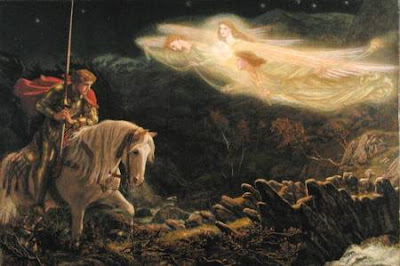If 2nd Edition AD&D is the reference, paladins are pretty rare. The stat requirements alone indicate that paladins are certainly not average:
Strength 12, Constitution 9, Wisdom 13, Charisma 17.
Getting a 9 Con isn't hard, and while 12 Str and 13 Wis is certainly above average, they're not difficult to get. It is the 17 Charisma that everyone knows is a challenge.
When rolling 3d6 getting a 17 Charisma requires rolling two sixes plus either a 5 or a 6 on the third dice. Getting a 17 or 18 are equally difficult when rolling 3d6 because there's only 2 ways to do it. Either 665 or 666. That's it. As anyone who has studied Finite Math knows, the order doesn't matter. 566 is still as equally hard to roll as 665. We are just organizing them in numerological order to keep it simple.
In contrast rolling a 16 is much easier. There are two ways to do it: 664 or 655.
And 15? Three ways to do that: 663, 654, 555.
Any character class with a stat requirement of 15 or higher is therefore pretty rare, as there is only so many ways to roll the stats needed to be a Druid or a Paladin, with paladins obviously being far more rare. Druids only need a 15 Charisma and there are 7 ways to roll that on 3d6. Paladins need a 17 or higher, so druids logically would be 3.5 times more common than paladins. At least that, because don't forget the paladin also needs to fulfill the Str, Con and Wis requirements.
And compared to commoners walking around with average stats of 10.5? Well, let's just say that being a peasant has no stat requirements other than being alive.
14: 662, 653, 644, 554
13: 661, 652, 643, 553, 544
12: 651, 642, 633, 552, 543, 444
11: 641, 632, 551, 542, 533, 443
10: 631, 622, 541, 532, 442, 433
9: 621, 531, 522, 441, 432, 333
And so on.
Basically there are twenty-four different ways to roll numbers between 9 and 12 on 3d6, but there are only sixteen ways to roll a stat of 13 or higher. And consequently, only sixteen ways to roll a 8 or lower. So only 56 possible rolls. Out of which only a 17 or 18 Charisma can be a paladin, so there's only 2 out of 56 ways to get the necessary Charisma requirement on 3d6.
So 3.57% of people would have the necessary Charisma.
Only 22 of 56 rolls would garner at 12 Str or higher, so 39.2% of people would be strong enough.
40 out of 56 would have 9 Con or higher, so 71.4%.
And 16 out of 56 would have 13 Wis or higher, so 28.6%.
The chances of getting ALL four of these stat requirements???
Roughly 0.286%. I ran the math twice to double check.
So out of 400 people rolled using the 3d6 dice method, only 1 person would have the necessary stats to potentially become a paladin.
So what about Alignment?
Not everyone is fit to be a paladin, even if they do have the necessary stats.
Being Lawful Good should be fairly rare, depending upon the fantasy world. Eg. Practically non-existent in a world like Dark Sun, but more common in a region like Solamnia in the Dragonlance world of Krynn. Or very common in a world like Eternia (He-Man and the Masters of the Universe, etc).
But if we fudge the averages a bit for argument's sake, the "average fantasy world" should have lots of people who are Neutral in alignment, with almost equal numbers of good and evil people.
Say: 30% good, 40% neutral, 30% evil.
It is fairly safe to say that in an "average" fantasy world there should be more neutral people than there is good people, and likewise evil people. But not necessarily more than both.
Likewise not everyone is lawful or chaotic. Many people are neutral in that respect. Thus it would be safe to say that lawful, neutral and chaotic people might be divided like so:
30% lawful, 40% neutral, 30% chaotic.
So even amongst a society of only Good people, only 30% of them would be Lawful Good.
And that compared to the average fantasy world only about 9% of people would be LG.
Taken together?
So only 1 in 400 people would have the necessary stats to be a paladin, but only 1 in 11 people would have the alignment requirement.
So only 1 in 4400 people could potentially become a paladin because they have the stats and alignment requirements.
But this assumes that person would even choose to BECOME a paladin. They might instead be a farmer, or a merchant, or a blacksmith. Any number of things.
If forced by circumstances, it makes sense that people might HAVE to become warriors, and potentially paladins if they had the right combination of stats and alignment. But it should still be really rare.
In a kingdom of perhaps 1 million people only 227 people would have the necessary alignment and stats. But what if most of them ended up becoming priests, warriors, farmers, merchants, etc?
Suffice to say, paladins, these paragons of virtue, should be almost as rare as unicorns.
And in certain worlds, like Dark Sun, paladins don't even exist. There are no paladins in Dark Sun, instead they have far more gladiators.
Some other worlds, like say one based on King Arthur and the Knights of the Round Table, well, paladins might be far more common.
And then there's the matter of the rolling system. Some DMs allow 4d6 drop the lowest, which skews the results and statistics.
And of course, what edition of Dungeons and Dragons a group is playing. It is far easier to become a paladin in 3rd or 5th edition. But for realism's sake there should only be so many.
And I didn't even touch on the topic of the death rate of paladins...













